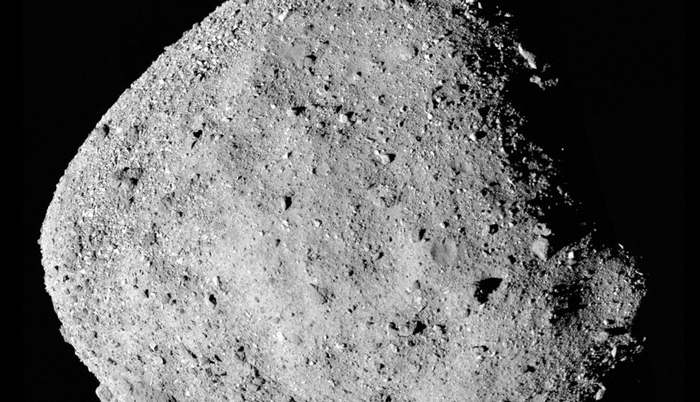![]() Home > Space & Science
Home > Space & Science
NASA's OSIRIS-Rex Returns Samples Of Asteroid Bennu To Earth After Historic 4-Billion-Mile Journey

This mosaic image of asteroid Bennu is composed of 12 images collected on Dec. 2, 2018 by the OSIRIS-REx spacecraft from a range of 15 miles (24 km). (Image credit: NASA/Goddard/University of Arizona)
![]() September 25th, 2023 | 11:53 AM |
September 25th, 2023 | 11:53 AM | ![]() 539 views
539 views
SPACE
"Touchdown for science!" NASA says. "We're all breathing a huge sigh of relief."
DUGWAY, Utah — NASA's first-ever samples of an asteroid in deep space have landed safely on Earth in a historic first for the United States.
In a mid-morning operation at the U.S. Army's Dugway Proving Ground in the arid Utah desert, teams with NASA and the U.S. Air Force successfully recovered a space capsule with samples of asteroid Bennu taken by the agency's OSIRIS-REx spacecraft in 2020. The mission marks the first time that NASA has taken a sample of an asteroid, not to mention successfully recovering it.
After traveling for over 4 billion miles (6.2 billion kilometers) to reach Bennu and then make the journey home, the OSIRIS-REx probe released its sample return capsule this morning while it was about 63,000 miles (101,000 km) above Earth. The capsule contains some 250 grams (8.8 ounces) of rocks and other material from Bennu, material that could help answer some of scientists' most burning questions about the origins of life on Earth and the early days of our solar system.
"Touchdown for science!" said Jim Garvin, chief scientist of NASA's Goddard Space Flight Center, from the landing site during a live broadcast. "For the first time in history, we brought goodies back home from this kind of object. This is so hige and we're all breathing a big sigh of relief."
The OSIRIS-REx capsule reached speeds of up to 27,000 mph (43,450 km/h) and its heatshield experienced temperatures as high as 5,300 degrees Fahrenheit (2,900 Celsius) as it descended through Earth's atmosphere.
The capsule deployed its main parachute at an altitude of about 20,000 feet, four times higher than expected at 5,000 feet, but it appeared to land safely. As it floated down to the desert floor of the U.S. Department of Defense's Utah Test and Training Range here, the capsule cooled down enough so that U.S. Air Force personnel could approach after locating it.
The descent from the edge of the atmosphere to the desert sands took just under 13 minutes in total to end a 4 billion-mile journey. The $1 billion OSIRIS-REx mission launched in 2016, arrived at Bennu in 2018 and collected samples of the asteroid in 2020.
Once on the ground, the capsule and surrounding area was examined to make sure it was safe for OSIRIS-REx team members and recovery personnel to approach and examine the capsule. An early examination by recovery teams found that the capsule was intact and suffered no breaches during landing.
From there, the capsule will be hooked up to a helicopter via a longline and airlifted to a temporary cleanroom set up at the U.S. Army's Dugway Proving Ground.
Once secure inside the facility, the capsule will be opened no earlier than Tuesday (Sept. 26), and the canister inside that contains the precious sample of asteroid Bennu will be prepared for transport once again. The asteroid material will next be loaded onto an aircraft and flown to NASA's Johnson Space Center (JSC) in Houston, Texas where a newly-built facility is waiting for it, the agency's Astromaterials Research and Exploration Science (ARES) division.
"Congratulations to the entire OSIRIS-REx team. You did it!," NASA Administrator Bill Nelson in a video during live commentary. "This mission proves that NASA does big things. Things that inspire us, things that unite us, things that show that nothing is beyond our reach."
From there, the sample will be divided up among different scientific institutions and world space agencies. NASA will keep 70% of the sample at JSC where it will analyze it for years to come. Another 25% will be shared between over 200 scientists at 35 different facilities. 4% will be given to the Canadian Space Agency, and another 0.5% will be given to the Japan Aerospace Exploration Agency (JAXA).
OSIRIS-REx is NASA's first to collect an asteroid sample, but JAXA has two such missions under its belt. That agency's Hayabusa 1 collected materials from asteroid Itokawa and returned them in 2010, and Hayabusa 2 returned sampled of asteroid Ryugu in 2020.
The successful landing and recovery of the asteroid Bennu samples marks the end of a seven-year mission that saw its share of surprises. When the spacecraft arrived at Bennu in 2018, it found an asteroid resembling more of a pile of gravel and rubble than a solid rock. Scientists with the mission then had to rethink the plan for the probe's landing, which required reprogramming the spacecraft to land in an area less than one quarter of the size of its original intended landing site.
But the OSIRIS-REx team pulled it off. Dante Lauretta, principal investigator of the mission, said during a pre-landing media briefing on Sept. 22 that the OSIRIS-REx team has been consistent in its ability to work through the unexpected issues that popped up.
"We've always taken a deliberate, careful, cautious approach," Lauretta said. "And I think that's why this mission has been so successful up to this date."
Source:
courtesy of ENGADGET
by Brett Tingley
If you have any stories or news that you would like to share with the global online community, please feel free to share it with us by contacting us directly at [email protected]